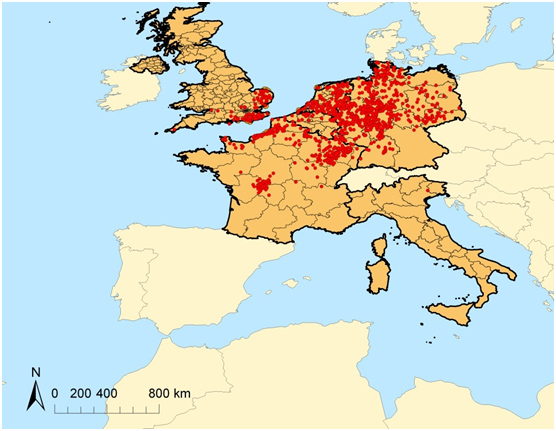Notable increase in the affection of farms with the Schmallenberg virus
 The OIE reported last March 9, 2012 a new notification, updating the situation in France against the infection by the Schmallenberg virus (SBV). Summing these data, 1,204 farms are affected by the SBV in Europe (Figure 1). As shown in the map, outbreaks have been an enormous expansion in France, reaching regions that are only 350 km from the border with Spain.
The OIE reported last March 9, 2012 a new notification, updating the situation in France against the infection by the Schmallenberg virus (SBV). Summing these data, 1,204 farms are affected by the SBV in Europe (Figure 1). As shown in the map, outbreaks have been an enormous expansion in France, reaching regions that are only 350 km from the border with Spain.

Fig. 1: Distribution of the infection by the Schmallenberg virus in Europe
Source: self-elaboration from data from the OIE-WAHID database up to March 9, 2012.
Apart from France, Germany and the Netherlands are the other two countries with the highest rates of infection with this virus. In all three, the sheep industry is worse off. In fact, among the three countries there have been 948 outbreaks in sheep (nearly 80% of total). With regard to cattle, these farms are not suffering so many malformations. In addition, the diagnosis of many samples from malformed fetuses (mostly done by RT-PCR) is testing negative. Therefore, the Dutch Central Veterinary Institute (CVI) has conducted a serological survey of 1,123 samples collected from dairy cows between November 2011 and January 2012 in order to ascertain the SBV status of the herd.
The study has resulted in an overall prevalence of 70%, on some farms reaching almost 100%. Firstly, there is a need for sensitive and affordable serological techniques for establishing the actual distribution pattern of this virus in the European Union. In addition, this shows that the virus has been actively circulating during the months of higher activity of the vector. In fact, a Belgian study conducted in pools of insects captured in late 2011 found the VSB in at least two vectors: Culicoides obsoletus and C. dewulfi. This shows that at least two species of midges are involved in the VSB transmission. Although more studies are necessary, important steps seem to be taken to unravel not only the past movement of the virus but also the present activity in order to ultimately know the real impact that this infection may lead.
All the information about Schmallenberg Virus is available at Emerging diseases online
Víctor Rodríguez Prieto & José Manuel Sánchez-Vizcaíno
SUAT-UCM
Source:
ProMED mail. Schmallenberg virus - Europe (25): Netherlands, serosurvey. File Number: 20120309.1065831.
ProMED mail. Schmallenberg virus - Europe (26): vector, morphology. File Number: 20120311.1066949


